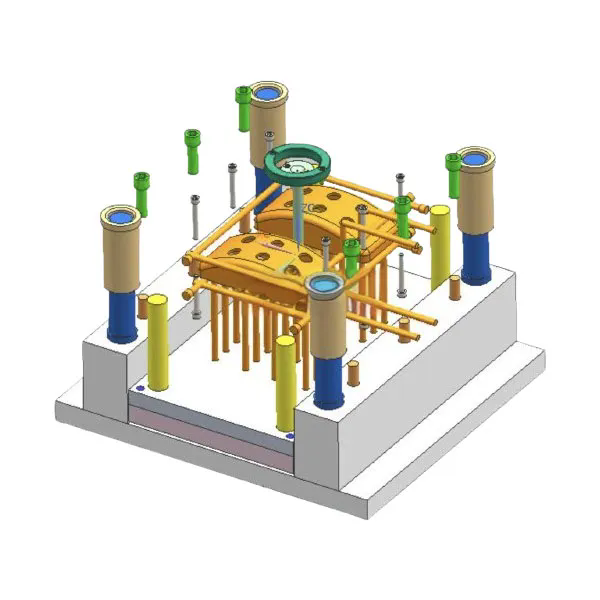The Art and Science of Mold Design: Key to Precision and Efficiency
2024-12-04
Mold design is a crucial process in manufacturing, especially in industries that rely on mass production and precision parts, such as automotive, electronics, and consumer goods. Whether creating plastic parts, metal components, or intricate designs, mold design serves as the foundation for producing high-quality products efficiently and consistently. This blog will explore the importance of mold design, the factors to consider, and how it impacts production processes.
What is Mold Design?
Mold design is the process of creating a mold that shapes raw material into a specific form. It involves planning, engineering, and fabricating a tool or mold that will be used in processes such as injection molding, die-casting, or compression molding. The mold serves as a negative or inverse of the product's final shape and is used to guide the material into a predefined structure under controlled conditions.
Why is Mold Design Important?
1. Precision and Quality
The quality of the final product depends largely on the design and precision of the mold. A well-designed mold ensures that the product will be produced with consistent dimensions, smooth surfaces, and minimal defects. Any imperfection in the mold design can lead to material waste, poor product quality, and costly repairs or replacements. This is why having an experienced mold designer is critical to achieving high-quality production results.
2. Cost Efficiency
The design phase directly impacts the overall production cost. A mold that is easy to manufacture, requires fewer adjustments, and is durable can help reduce long-term costs. Conversely, a poorly designed mold can lead to expensive delays, repairs, and even rework of the final product. Additionally, optimizing the mold design to improve efficiency in the manufacturing process can reduce energy usage, material waste, and cycle time, making the process more cost-effective.
3. Time to Market
In today’s competitive market, time is of the essence. A well-optimized mold design speeds up production cycles, helping manufacturers deliver products to the market faster. By minimizing downtime and reducing errors during production, the lead time is shortened, which is essential for companies looking to gain a competitive edge.
4. Innovation and Complexity
As products become more intricate, the complexity of mold design increases. Molds need to be designed to handle intricate geometries, multi-material components, and specific features such as textures or logos. Advanced mold designs enable the manufacturing of innovative products with intricate features while maintaining functionality and quality.
Key Factors to Consider in Mold Design
1. Material Selection
Choosing the right material for the mold is one of the most crucial decisions in the design process. The material must withstand the temperatures and pressures involved in the manufacturing process without compromising the mold’s integrity. For plastic molds, materials such as steel or aluminum are commonly used, as they provide the necessary strength and durability.
2. Mold Type
There are various types of molds based on the material being molded and the method of production. Common types include single cavity, multi-cavity, and family molds. A single cavity mold creates one product per cycle, while multi-cavity molds can produce several products at once, improving efficiency. Family molds are used to create multiple parts in a single cycle, allowing for more complex products that combine several components.
3. Cooling System
Efficient cooling is critical to mold design. If a mold is not cooled quickly enough, it can cause issues like warping, defects, and extended cycle times. A good cooling system helps control the temperature of the mold, ensuring that the material cools at a consistent rate. The design should include channels that allow for effective cooling, which, in turn, improves the quality of the product and shortens production times.
4. Ejection Mechanism
Once the material has been molded, it needs to be ejected from the mold without damage. The design must include an effective ejection mechanism to ensure the product is removed smoothly. This mechanism typically consists of pins, plates, or a combination of both, and is essential to avoid damage to the molded part.
5. Ventilation
Proper ventilation is crucial to prevent air from being trapped in the mold during the injection or casting process. Trapped air can cause defects such as burn marks or incomplete filling. By designing proper venting, designers ensure that the mold can vent excess air and prevent these issues, ensuring a higher-quality product.
The Mold Design Process
1. Concept and Design
The mold design process begins with an initial concept based on the product’s specifications. The design team evaluates the product’s material, size, complexity, and intended use to determine the best molding method. They create 3D models using CAD (Computer-Aided Design) software, which allows them to visualize the mold and ensure it meets all the necessary specifications.
2. Prototype and Testing
After the design is completed, a prototype of the mold is usually created. This prototype is tested to ensure that it works correctly, and any issues with the design can be identified and corrected before full-scale production begins. This stage is essential for fine-tuning the mold design to ensure its durability and functionality.
3. Fabrication
Once the mold is finalized, it is fabricated using specialized machinery, including CNC (Computer Numerical Control) machines, EDM (Electrical Discharge Machining) machines, and milling equipment. These machines ensure that the mold is manufactured with high precision and can handle the required production volumes.
4. Production and Maintenance
After the mold is fabricated, it is used in the production process. However, regular maintenance is essential to ensure the mold’s longevity and performance. Molds may require cleaning, repairs, and adjustments after each production run to maintain their functionality and prevent wear and tear from affecting the product’s quality.
The Future of Mold Design
Advancements in technology, such as 3D printing and artificial intelligence, are revolutionizing mold design. 3D printing allows for rapid prototyping, reducing the time and cost associated with creating and testing molds. Additionally, AI is being used to optimize mold designs for specific production requirements, resulting in improved performance and reduced design iterations.
Furthermore, the rise of automation and smart manufacturing processes will continue to streamline mold design and production, improving precision, reducing labor costs, and increasing production speed.
Conclusion
Mold design is an essential aspect of manufacturing, directly impacting product quality, production efficiency, and cost-effectiveness. By considering factors like material selection, cooling systems, and ejection mechanisms, manufacturers can design molds that ensure the smooth creation of high-quality products. As technology advances, mold design will continue to evolve, enabling more complex and innovative products to be made with greater efficiency. Ultimately, investing in good mold design not only saves time and money but also contributes to creating products that meet the ever-increasing demands of today’s market.



